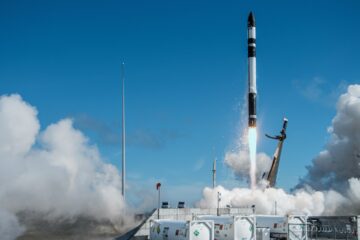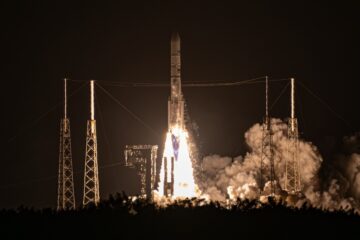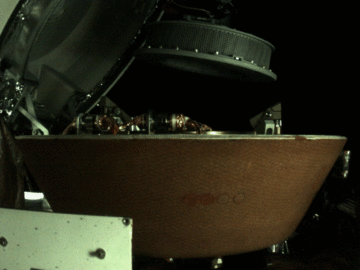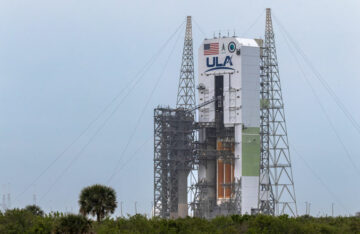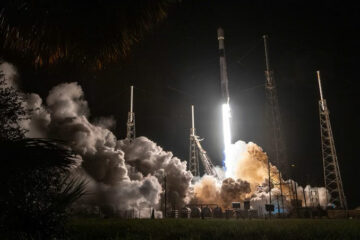
The earliest NASA’s first Space Launch System moon rocket could roll out from the Vehicle Assembly Building to its seaside launch complex in Florida is in late November, officials told Spaceflight Now, leaving little time to conduct a critical fueling test, roll the rocket back into the VAB for final closeouts, then return to the pad for liftoff before the end of the year.
Stacking and testing of the SLS heavy-lift rocket has taken longer than NASA’s best-case projections earlier this year. But that’s not unexpected for the first time teams have assembled the powerful new launch vehicle inside the VAB at NASA’s Kennedy Space Center.
“It’s gone well, in my opinion, for first-time operations,” said Cliff Lanham, senior vehicle operations manager for NASA’s exploration ground systems program, in a recent interview with Spaceflight Now. “Everything is new for us, but in general, things have gone well.”
Lanham said NASA, supported by ground systems contractor Jacobs, intentionally delayed stacking of some elements of the Space Launch System this summer to complete some “higher-priority” work in the critical path for the first unpiloted SLS test flight, which NASA calls Artemis 1.
The higher-priority tasks included an initial power up of the SLS core stage avionics, and loading of flight software into the rocket’s computer system. The work also involved checkouts of an environmental control system before power-up of the rocket.
NASA engineers have not discovered any major problems during the SLS testing, but key milestones leading up to the Artemis 1 launch have been steadily sliding to the right in NASA’s processing schedule.
Before NASA raised the Boeing-made SLS core stage onto its mobile launch platform inside High Bay 3 of the VAB in June, managers hoped to connect he Orion spacecraft for the Artemis 1 mission on top of the rocket in August. That’s now expected this fall.
The first rollout of the 322-foot-tall (98-meter) rocket from the VAB to launch pad 39B was scheduled no earlier than September. That’s now expected in late November, at the soonest, according to Lanham.
The schedule slips, while not significant amid the history of SLS program delays, have put a major crunch on NASA’s ambition to launch the Artemis 1 mission this year. The agency is evaluating Artemis 1 launch opportunities in the second half of December, multiple sources said, but that would require NASA to cut in half the time it originally allotted between the SLS fueling test and the actual launch date.
Earlier this month, NASA stacked a test article of the Orion Stage Adapter on top of the SLS in High Bay. The flight adapter will connect the Orion spacecraft with the SLS upper stage, and will also carry around a dozen CubeSats into deep space as rideshare payloads.
Then ground teams lifted a cylinder called the Mass Simulator for Orion on top of the rocket. That structure mimics the weight of the Lockheed Martin-built Orion spacecraft, allowing technicians to complete resonance measurements on the entire rocket stack, a milestone NASA calls modal testing.

With the mass simulator stacked, ground teams began a series of interface verification tests earlier this. Those will be followed by an Umbilical Release and Retract Test, in which engineers will verify the release system for the swing arms routing fluid and support connections between the mobile launch tower and the SLS rocket.
The swing arms will rotate or drop away from the rocket at liftoff.
Then teams will move into modal testing. Stingers, or shakers, will introduce vibrations to the rocket as it stands on its support posts at the base of the mobile launch platform. Sensors across the rocket and along the mobile launch tower, will measure the resonant response to the vibrations.
রকেটের টুইন সাইড-মাউন্ট করা সলিড-ফুয়েলড বুস্টার প্রতিটি গাড়ির চারটি সাপোর্ট পোস্টে দাঁড়িয়ে থাকে, গাড়ির ওজন মোবাইল প্ল্যাটফর্মে ধরে রাখে — হোল্ড-ডাউন বোল্টের সমর্থন ছাড়াই — স্ট্যাকিং, রোলআউট এবং উত্তোলনের আগে কাউন্টডাউনের সময়।
Lanham said NASA’s ground systems team hopes to finish the modal testing in September.
So we would get into, you know, towards the end of August into early September timeframe, we would get into URL T followed by modal, and ideally finish up in the middle of September with modal testing.
এর পরে ওরিয়ন ভর সিমুলেটর এবং ওরিয়ন স্টেজ অ্যাডাপ্টার পরীক্ষা নিবন্ধটি অপসারণ করা হবে। এগুলিকে ফ্লাইট-রেডি স্টেজ অ্যাডাপ্টার এবং আসল ওরিয়ন মহাকাশযান দ্বারা প্রতিস্থাপিত করা হবে, যেটি মহাকাশে চালনা চালানোর প্রপেলান্ট দিয়ে জ্বালানী করা হয়েছে এবং কেনেডিতে এর লঞ্চ অ্যাবর্ট সিস্টেমের সাথে মিলিত হয়েছে।
Technicians are completing installation of ogive fairings over the top of the Orion spacecraft, providing the aerodynamic shield that will cover the capsule during launch.
ওরিয়ন মহাকাশযান এবং SLS রকেটের মধ্যে যান্ত্রিক এবং বৈদ্যুতিক সংযোগ যাচাই করার জন্য অতিরিক্ত পরীক্ষার পরে, NASA সম্পূর্ণরূপে একত্রিত লঞ্চারটিকে এজেন্সির অ্যাপোলো-যুগের ক্রলার ট্রান্সপোর্টারগুলির মধ্যে একটির উপরে প্যাড 39B-এ রোল করার জন্য প্রস্তুত হবে।
NASA এর লঞ্চ টিম একটি সিমুলেটেড কাউন্টডাউনের মধ্য দিয়ে চলার আগে রকেটটি প্যাডে প্রায় এক সপ্তাহ ব্যয় করবে, যার পরিণতি লঞ্চ ভেহিকেলে সুপার-হোল্ড লিকুইড হাইড্রোজেন এবং তরল অক্সিজেন লোড করা হবে।
ওয়েট ড্রেস রিহার্সাল হিসাবে পরিচিত এই পরীক্ষাটি সফল হয়েছে বলে ধরে নিলে, দলগুলি প্রপেলান্ট নিষ্কাশন করবে, রকেটকে নিরাপদ করবে এবং চূড়ান্ত ক্লোজআউটের জন্য যানবাহন সমাবেশ বিল্ডিং-এ স্পেস লঞ্চ সিস্টেম ফিরিয়ে দেবে।
ওয়েট ড্রেস রিহার্সালের পর VAB-এর অভ্যন্তরে সময়-সংবেদনশীল কাজের মধ্যে রকেটের বিচ্ছেদ ব্যবস্থা এবং রেঞ্জ নিরাপত্তা ধ্বংস প্রক্রিয়ার জন্য পাইরোটেকনিক অর্ডন্যান্স ইনস্টল করা অন্তর্ভুক্ত থাকবে, যা রকেটটি লিফ্টঅফের পরে অবশ্যই উড়ে গেলে ফ্লাইটটি বন্ধ করে দেবে।
তারপরে রকেটটি প্রথম উৎক্ষেপণের প্রচেষ্টার আগে প্রস্তুতির আরও এক সপ্তাহের জন্য প্যাড 39B-তে ফিরে আসবে।
During launch, the core stage’s Aerojet Rocketdyne RS-25 engines and twin solid rocket boosters will generate 8.8 million pounds of thrust. It can send about 59,500 pounds (27 metric tons) of payload to the moon, according to NASA.
The Artemis 1 mission will propel the Orion spacecraft on a mission to orbit the moon for several weeks, before the capsule returns to Earth for a splashdown in the Pacific Ocean. Artemis 1 will pave the way for the next SLS/Orion mission, Artemis 2, to carry a four-person crew around the moon in 2023.
Artemis missions later in the 2020s will land astronauts near the south pole of the moon using commercially-developed lunar landers. In April, NASA selected a variant of SpaceX’s Starship, a reusable heavy-lift rocket being developed with majority private funding, to land the first Artemis crew on the moon.
But NASA plans to use the government-owned Space Launch System rocket and Orion capsule for the round-trip flight between Earth and the vicinity of the moon, where astronauts will transfer into a lunar lander, such as the Starship, for descent to the surface.
ই-মেইল লেখক.
টুইটারে স্টিফেন ক্লার্ক অনুসরণ করুন: @ স্টিফেন ক্লার্ক 1.
Source: https://spaceflightnow.com/2021/08/31/nasa-hopes-waning-for-sls-test-flight-this-year/
- "
- অতিরিক্ত
- অনুমতি
- এপ্রিল
- কাছাকাছি
- প্রবন্ধ
- আগস্ট
- উপসাগর
- বিল
- ভবন
- সংযোগ
- ঠিকাদার
- ধার
- বিলম্ব
- আবিষ্কৃত
- ডজন
- ড্রপ
- গোড়ার দিকে
- প্রকৌশলী
- পরিবেশ
- অন্বেষণ
- ফেসবুক
- প্রথম
- প্রথমবার
- ফ্লাইট
- ফ্লোরিডা
- তহবিল
- সাধারণ
- গুগল
- উচ্চ
- ইতিহাস
- HTTPS দ্বারা
- উদ্জান
- সাক্ষাত্কার
- জড়িত
- IT
- জুলাই
- চাবি
- শুরু করা
- নেতৃত্ব
- তরল
- চান্দ্র
- চন্দ্র ল্যান্ডার
- মুখ্য
- সংখ্যাগুরু
- মাপ
- মিলিয়ন
- মিশন
- মোবাইল
- চন্দ্র
- পদক্ষেপ
- নাসা
- কাছাকাছি
- মহাসাগর
- অপারেশনস
- অভিমত
- সুযোগ
- অক্সিজেন
- শান্তিপ্রয়াসী
- মাচা
- পোস্ট
- পাউন্ড
- ক্ষমতা
- ব্যক্তিগত
- কার্যক্রম
- পরিসর
- প্রতিক্রিয়া
- আয়
- রোল
- নিরাপদ
- নিরাপত্তা
- নির্বাচিত
- সেন্সর
- ক্রম
- শেয়ার
- কাল্পনিক
- সফটওয়্যার
- দক্ষিণ
- স্থান
- মহাকাশযান
- মহাকাশ
- ব্যয় করা
- পর্যায়
- Starship
- সাফল্য
- গ্রীষ্ম
- সমর্থন
- সমর্থিত
- পৃষ্ঠতল
- পদ্ধতি
- সিস্টেম
- পরীক্ষা
- পরীক্ষামূলক
- পরীক্ষা
- সময়
- টন
- শীর্ষ
- কিচ্কিচ্
- টুইটার
- us
- বাহন
- প্রতিপাদন
- সপ্তাহান্তিক কাল
- হয়া যাই ?
- বছর


